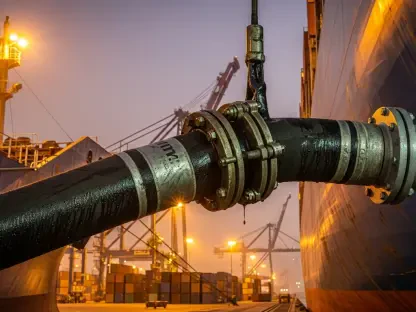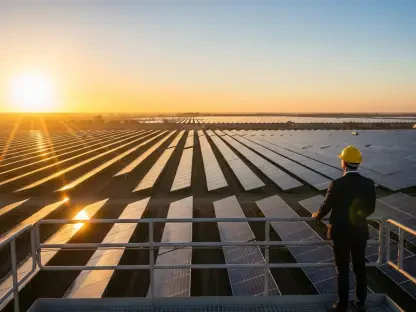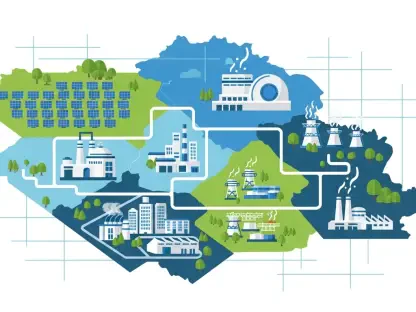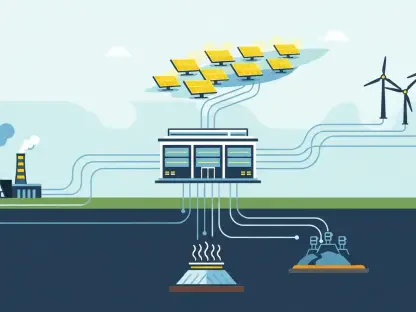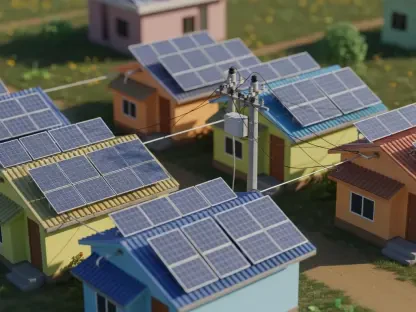Arizona stands at the forefront of a digital revolution, grappling with an unprecedented surge in energy demand as data centers multiply across the desert landscape, fueled by the state’s favorable climate and business environment. With projections indicating that energy needs could double within a decade, utilities are racing to secure reliable fuel supplies to power this technological boom while also accommodating a rapidly growing population. This report delves into the strategic measures taken by Arizona’s major utilities to address these challenges, focusing on natural gas pipeline expansions and the intricate balance between reliability and sustainability in an evolving energy ecosystem.
The Surge in Energy Demand: Data Centers and Population Growth in Arizona
Arizona has emerged as a powerhouse in the data center industry, ranking second only to Northern Virginia as a key U.S. market for such facilities. The proliferation of these energy-intensive hubs, driven by the global demand for cloud computing and artificial intelligence, has placed immense pressure on the state’s power grid. Major utilities like Arizona Public Service (APS) and Salt River Project (SRP) are at the helm of addressing this demand, with APS alone reporting pending interconnection requests totaling 10 gigawatts (GW) from data centers, a figure that dwarfs many regional grids.
Beyond data centers, Arizona’s population growth adds another layer of complexity to the energy equation. The Phoenix metropolitan area, a hub for both residential and industrial expansion, continues to attract new residents and businesses, pushing utilities to plan for sustained increases in electricity consumption. SRP, for instance, anticipates the need to double its generating resources within the next ten years to keep pace with this dual growth trajectory, highlighting the urgency of infrastructure upgrades.
The stakes are high as both APS and SRP confront record-breaking peak demands, with APS surpassing its previous high of 8.5 GW and expecting continuous annual records due to large customer loads. This convergence of technological and demographic trends underscores Arizona’s critical role in the national energy landscape, setting the stage for innovative solutions to meet escalating needs.
Strategic Fuel Supply Solutions Through Pipeline Expansion
Desert Southwest Expansion Project Details
To address the looming energy crunch, Energy Transfer’s Transwestern Pipeline has embarked on the ambitious Desert Southwest expansion, a $5.3 billion project designed to transport natural gas from the Permian Basin in West Texas to Arizona. Spanning 516 miles, this pipeline will boast a capacity of 1.5 billion cubic feet per day (Bcf/d), providing a vital lifeline for utilities struggling to secure fuel for gas-powered plants. The project is slated to commence operations by the fourth quarter of 2029, marking a significant milestone in Arizona’s energy infrastructure development.
Further growth potential lies on the horizon, as Energy Transfer plans to gauge additional demand through an open season solicitation. This process will determine whether capacity expansions or route adjustments are necessary, ensuring the pipeline can adapt to future needs. Such foresight is crucial in a state where energy consumption projections are continually revised upward, driven by unforeseen technological advancements and industrial investments.
Collaborative Efforts Among Arizona Utilities
In a display of regional solidarity, Arizona’s utilities have united to secure pipeline capacity, recognizing the shared imperative of reliable energy supply. APS and SRP have independently forged agreements with Energy Transfer, while other entities like Tucson Electric Power (TEP), UniSource, and the City of Mesa are finalizing their commitments. This collaborative approach reflects a broader consensus on the indispensability of natural gas infrastructure to support both current and projected demand.
The partnerships extend beyond mere capacity reservations, embodying a strategic alignment on affordability and reliability. Natural gas, as a flexible and relatively cost-effective fuel, remains a cornerstone of utility planning, especially as data centers and population centers push grid limits. This collective effort among Arizona’s energy providers exemplifies a proactive stance toward mitigating supply risks in a high-stakes environment.
Challenges in Meeting Unprecedented Energy Needs
The rapid escalation of energy demand in Arizona presents a multifaceted challenge for utilities, particularly in aligning infrastructure development with immediate needs. Pipeline projects like Desert Southwest, while promising, face lengthy timelines that may not keep pace with the urgent requirements of data centers and growing communities. Delays in construction or regulatory approvals could exacerbate supply constraints, leaving utilities vulnerable to shortfalls.
Moreover, the volatility of natural gas prices poses a financial risk, as fluctuations could impact the affordability of power generation over the long term. Utilities must navigate these economic uncertainties while ensuring that gas-fired plants remain a viable backup during peak loads or renewable energy lulls. This balancing act is further complicated by capacity constraints on existing infrastructure, which may struggle to accommodate sudden demand spikes.
Integrating renewable energy sources into the grid adds another dimension of difficulty, as solar and wind power, while sustainable, require robust backup systems to maintain stability. The intermittent nature of renewables necessitates a strong reliance on natural gas, yet the transition toward greener energy must not be sidelined. Arizona’s utilities face the daunting task of harmonizing these diverse energy streams to ensure uninterrupted service amid unprecedented growth.
Navigating the Regulatory and Sustainability Landscape
The expansion of natural gas infrastructure in Arizona operates within a complex regulatory framework that governs pipeline approvals and energy procurement. State and federal oversight ensures that projects like Desert Southwest adhere to environmental and safety standards, a process that can introduce delays but is essential for public trust. Utilities must engage with regulators to streamline approvals while addressing community concerns over land use and emissions.
Sustainability remains a parallel priority, as APS and SRP strive to balance grid reliability with ambitious clean energy goals. APS, for instance, has committed to significant renewable resource additions through recent procurement initiatives, while SRP advocates an “all-of-the-above” strategy that incorporates solar, wind, and storage alongside natural gas. This dual focus reflects a broader industry trend toward decarbonization without compromising service quality.
The regulatory landscape also shapes how utilities plan for future growth, requiring transparent resource planning and stakeholder engagement. As Arizona navigates this terrain, the interplay between maintaining a stable power supply and advancing environmental objectives will define the state’s energy policies. Striking this balance is critical to sustaining both economic progress and ecological responsibility in a rapidly changing market.
Future Outlook: Energy Infrastructure and Data Center Growth
Looking ahead, the proliferation of data centers in Arizona is poised to reshape the state’s energy landscape, with utilities like APS forecasting continuous peak demand records driven by large-scale customer loads. The trend signals a long-term shift in consumption patterns, necessitating sustained investments in both generation and transmission infrastructure to prevent bottlenecks. Natural gas will likely remain a linchpin in this evolving grid, providing the reliability needed to support intermittent renewables.
Emerging industry practices, such as direct gas supply agreements between pipeline operators and data center developers, point to innovative solutions on the horizon. A notable example is Energy Transfer’s deal with CloudBurst to supply up to 450,000 MMBtu/day for a Texas data center campus, a model that could expand across the national pipeline network. Such arrangements highlight the growing nexus between energy providers and technology sectors, potentially redefining fuel procurement strategies.
The broader implications for Arizona include the possibility of further pipeline expansions beyond the Desert Southwest project, as open season solicitations gauge interest from diverse sectors like industrial facilities and power plants. This adaptability in infrastructure planning will be essential to accommodate unforeseen demand surges and maintain the state’s competitive edge as a data center hub. The trajectory suggests a dynamic future where energy and technology intersect with increasing frequency.
Conclusion: Arizona’s Energy Ecosystem at a Turning Point
Reflecting on the strides made by Arizona’s utilities, it becomes evident that strategic investments in natural gas infrastructure, exemplified by the Desert Southwest pipeline, play a pivotal role in addressing the state’s burgeoning energy demands. The collaborative spirit among APS, SRP, and regional partners lays a strong foundation for reliability, even as challenges like project timelines and price volatility persist. These efforts underscore a commitment to powering growth without sacrificing service quality.
Moving forward, a key consideration emerges in the need for accelerated regulatory processes to match the pace of demand, ensuring that infrastructure projects keep stride with data center expansions. Exploring hybrid energy models that further integrate renewables with gas backups offers a pathway to enhance sustainability while maintaining grid stability. Arizona’s utilities stand poised to lead by example, investing in adaptive strategies to secure a resilient energy future.
Finally, fostering innovation in direct supply agreements and pipeline scalability presents an actionable step to sustain Arizona’s position as a technology and energy leader. By prioritizing these areas, stakeholders can transform challenges into opportunities, building an energy ecosystem that supports both economic vitality and environmental stewardship for years to come.


